In the United States, the prevalence of back pain has increased, as has the number of individuals seeking treatment through complementary and alternative medicine (CAM).
Acupuncture, spinal manipulation, massage, yoga, tai chi, chiropractic, biofeedback, and mindfulness-based stress-reduction therapy have all been shown to aid with back pain without the need for medicines or surgery.
These therapies can help ease muscle tension, relieve pain, and correct posture while strengthening muscles and improving joint stability.
The most prevalent CAM therapies for back pain in the US are spinal manipulation, acupuncture, and massage.
Lower Back Pain (LBP) is one of the most common types of chronic back pain and is often caused by lumbar muscle strain and sprains. Adults between the ages of 18 to 64 years represent 72% of all low back pain healthcare visits.
Naturally, there are many studies on treatment methods for lower back pain, including the efficacy of acupuncture in managing this pain.
In a comprehensive study, 454,920 patients with at least one of the three chronic pain conditions including headache, low back pain, and osteoarthritis were treated with acupuncture. The effectiveness of acupuncture was rated as marked or moderate in 76% of the patients.
A meta-analysis reviewing nearly 20,000 people for chronic pain, including chronic back pain, found that those who received real acupuncture compared to those who received sham acupuncture or no acupuncture experienced a 50% improvement in chronic pain.
The study concluded, “Acupuncture is effective for the treatment of chronic pain and is, therefore, a reasonable referral option.”
More recently, a systematic review and meta-analysis of effects of acupuncture on pain and function in non-specific low back pain, found that acupuncture is more effective at pain relief than sham acupuncture or no treatment at all. Acupuncture with usual care methods for back pain is more effective than just usual care alone, making acupuncture an important supplemental treatment to usual care methods, according to this study.
There is no need to go through life suffering from low back pain, call today and schedule an appointment to start living without low back pain.
According to statistics, nearly eight out of ten people will suffer from low back pain at some point in their lives. It is typical to seek medical therapy for back discomfort. Back discomfort is usually only temporary and can be treated with rest, heat, and an anti-inflammatory like ibuprofen on occasion. However, once the damage has been done, back pain can reoccur up to 50% of the time. Part of this is since muscles and tendons become less flexible and malleable as we age. It is also well acknowledged that people in the United States are overly sedentary, which contributes to excess weight gain and increased pressure on the body, particularly the low back.
Traditional Chinese Medicine (TCM) is a roughly 3,000-year-old medicinal system. TCM, however, has a lot of value to offer in the age of modern medicine, despite its age. Low back pain can be treated in a variety of methods in TCM. Here are a few examples of how this old medical method can be of use.
Acupuncture for Low Back Pain: Studies have shown that acupuncture stimulates the body to produce natural steroids that reduce inflammation. Acupuncture also increases the production of endorphins, which are helpful in reducing pain. In this way, acupuncture can be very helpful in preventing costly surgeries or prescription pain medication addiction. If a person seeks out acupuncture treatments when the low back pain is acute, it can potentially help them avoid chronic pain, thus decreasing the need for pain medications or surgery.
Acupuncture Points for Low Back Pain:
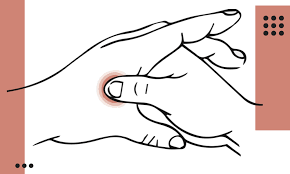 Large Intestine 4 – This point is located bilaterally on the backside of the hand, in the webbing between the forefinger and the thumb. When the hand is made into a fist, the point can is found in the center of the mound of flesh that is created. This point is used for relieving pain anywhere in the body.
Large Intestine 4 – This point is located bilaterally on the backside of the hand, in the webbing between the forefinger and the thumb. When the hand is made into a fist, the point can is found in the center of the mound of flesh that is created. This point is used for relieving pain anywhere in the body.
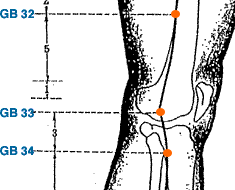 Gallbladder 34 – This point is found bilaterally on the outer side of the lower leg. It can be found in the depression that is in front of and below the head of the fibula. This point is known as the influential point of the tendons.
Gallbladder 34 – This point is found bilaterally on the outer side of the lower leg. It can be found in the depression that is in front of and below the head of the fibula. This point is known as the influential point of the tendons.
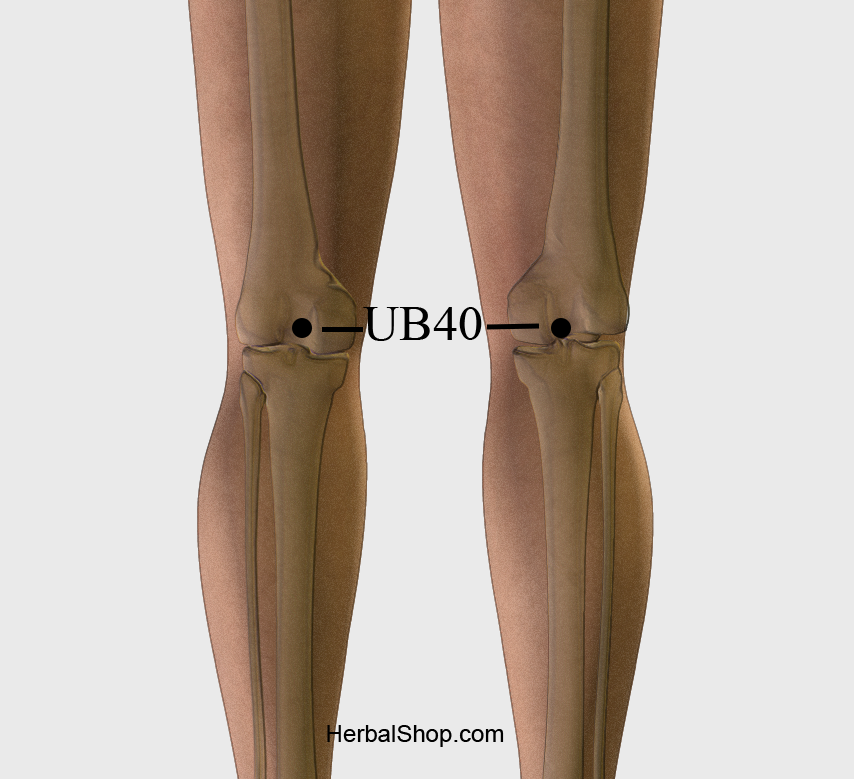 Urinary Bladder 40 – This point is located bilaterally on the crease behind the knee, right in the center, directly behind the knee cap. This point helps relieve pain along the spine. It is helpful for relieving muscle spasms and reducing pain associated with sciatic nerve involvement, which stems from the low back.
Urinary Bladder 40 – This point is located bilaterally on the crease behind the knee, right in the center, directly behind the knee cap. This point helps relieve pain along the spine. It is helpful for relieving muscle spasms and reducing pain associated with sciatic nerve involvement, which stems from the low back.
Chinese Herbs for Low Back Pain: Herbs and combinations of herbs, known as formulas, are used frequently in TCM. They can be used topically in the form of balms or salves, and they can also be taken internally. One specific herb that is found frequently in low back pain formulas is Xu Duan. This herb is used because it strengthens the sinews, promoted blood circulation, and alleviates pain.
Most herbal formulas have specific herbs in them that help target the areas that are affected. For instance, Du Huo Ji Sheng Tang contains herbs that target the muscles and sinews of the low back area to alleviate pain and inflammation.
Nutrition for Low Back Pain: Proper nutrition is vital for everyone, but for those suffering from low back pain, it can be extra important to provide the body with the right nutrients. Fatty fish, like tuna and salmon, provide omega-3 fatty acids that can help reduce inflammation. Grapes and berries contain antioxidants and anti-inflammatory components that inhibit enzymes responsible for pain. Hemp seeds are another great food to consume if you are suffering from low back pain. Full of anti-inflammatory properties and healthy fats, hemp seeds can decrease pain and inflammation.
As you can see, TCM is a great way to deal with low back pain. If you are experiencing this problem, call us today, and let’s see how we can help you relieve your back pain.
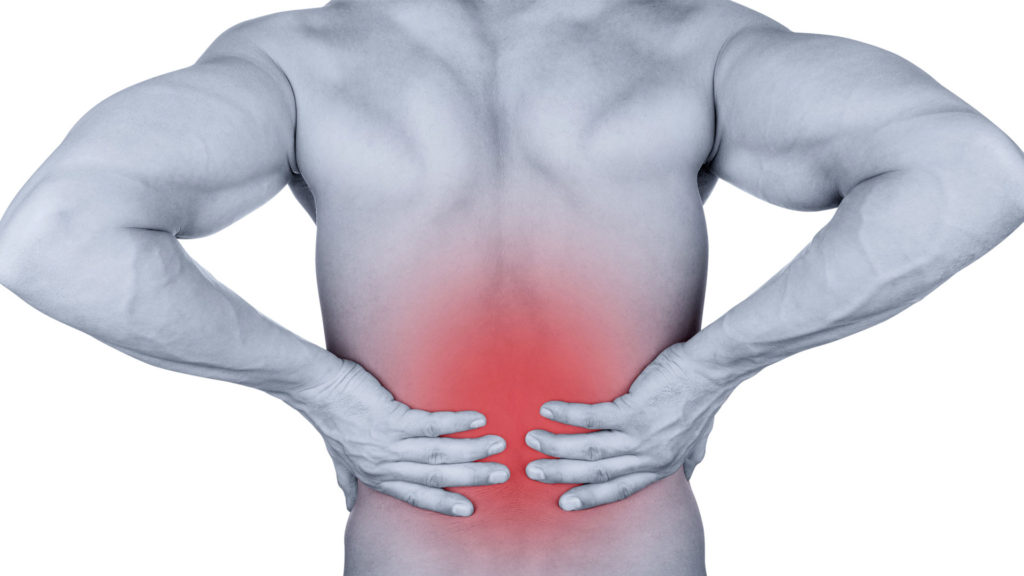
In Chinese medical theory, the most basic distinction between types of pain is whether they are due to ‘deficiency’ or ‘stagnation,’ both at the site of pain and systemically.
In this article, we’ll look at what deficiency pain means.
Deficiency Pain
Deficiency refers to a lack of one or both of Qi and blood. Each of these can be deficient in a couple of ways themselves.
Qi Deficiency
A deficiency of Qi can be expressed as the inability of a muscle to fully contract and then relax, or as a functional pattern of imbalance due to neurological habituation.
Neurological habituation causes a communication line between some part of the body and the brain to become weak. In this case, Qi can be seen as the impetus of nerve signaling and the ability of the tissue to communicate with its environment.
For example, when sitting at a desk, our bodies don’t generally demand the gluteus muscles activate (we are just using them as cushions), so after a period of time our brains tend to ignore those muscles in favor of more actively used body parts such as the low back, hands and eyes. Over days, weeks, and years of this pattern of inactivity, the neurological connection between our brain and our glutes becomes less robust, and it becomes more difficult to ‘fire’ those muscles when we really do need them, like when running.
This sets up a pattern of a different muscle activating (say, muscles of the low back) to try to perform functions which another muscle is best suited for (say, the glutes). This then leads to the overuse of the low back, but this overuse is actually due to a deficiency in another location. So pain might manifest in the low back or in the glutes (as a referral of pain from the tense low back), all because the original neurological signaling network has been compromised.
Another type of Qi deficiency, the type disallowing the muscle to truly contract and then relax, is tied into general deficiency of the body tissues. This type of deficiency manifests as people age and the muscles become more tense by default, losing the full responsiveness, flexibility, and easy range of motion that we experience as children.
Blood deficiency
Blood deficiency can be due to multiple factors as well, but the two main ideas are either lack of blood flow to the site of pain or lack of proper oxygenation and nutrition within the blood to power the full potential of the tissues.
An inability of the blood to perfuse the site of pain is compounded by many factors. Some tissues naturally receive more blood than others. For example, skin and muscle tissue have many capillaries providing blood to the tissue, while tendons, ligaments, all kinds of connective tissue and bone often have very little access to fresh blood.
The Chinese medical theory of blood deficiency includes the inability to move the blood to the correct sites at the correct times, and a lack of energy to allow the blood to reach all of the tissues in an optimal way. This impacts the rate of recovery from daily stresses on the tissues. Over time, as these stresses do not repair, they initiate dysfunction and inflammation, which may irritate or impinge nearby nerves.
Once the blood flow has been compromised and pain sets in, the ability of the area to recover blood flow is directly related to how quickly the pain will dissipate and how long it will take to recover completely. The less blood flow, generally the longer the recovery time.
Deficiencies of the content of the blood are related to the function of the organ systems as well as dietary habit. Most famously, magnesium deficiency can cause muscle cramps, so athletes are often advised to eat things like bananas and avocados, fruits high in magnesium.
However, there are many nutrients necessary for optimal function of the musculoskeletal system. According to Chinese medical theory, the ability of the blood to deliver collagen-building material to the connective tissues is just as important as the ability of the blood to deliver magnesium to muscles. Both can lead to major pain if not carried out.
Statistics show that almost eight out of 10 people experience low back pain at some point during their life. Seeking medical treatment for back pain is very common. Typically, back pain is fleeting and can be easily resolved with rest, heat, and an occasional anti-inflammatory like ibuprofen. However, once the damage is done, the recurrence of back pain can be as high as 50 percent. Part of this is because as we age, things like muscles and tendons become less flexible and pliable. This can also be attributed to the fact that many people suffer from low-grade dehydration because they don’t drink enough water and they don’t ingest enough healthy fats that keep the muscles and tendons loose. It is also very well known that in the United States, people are too sedentary, and this leads to excess weight gain that can create added pressure on the body, especially the low back.
Studies have shown acupuncture stimulates the body to produce natural steroids that reduce inflammation. Acupuncture also increases the production of endorphins, which are helpful in reducing pain. In this way, acupuncture can be very helpful in preventing costly surgeries or prescription pain medication addiction. If a person seeks out acupuncture treatments when the low back pain is acute, it can potentially help them avoid chronic pain.
Along these lines, there are also some things that can be done at home to help with low back pain. Acupressure uses the same concept of acupuncture without the needles. By applying pressure to specific acupoints with either a finger or a smooth rounded instrument, it is possible to decrease low back pain until an acupuncture treatment can be scheduled. Here are three acupoints that can be used to help with low back pain.
• Large Intestine 4 – This point is located bilaterally on the backside of the hand, in the webbing between the forefinger and the thumb. When the hand is made into a fist, the point can be located in the center of the mound of flesh that is created. This point is used for relieving pain anywhere in the body.
• Gallbladder 34 – This point is found bilaterally on the outer side of the lower leg. It can be found in the depression that is in front of and below the head of the fibula. This point is known as the influential point of the tendons.
• Urinary Bladder 40 – This point is located bilaterally on the crease behind the knee, right in the center, directly behind the knee cap. This point helps relieve pain along the spine. It is helpful for relieving muscle spasms and reducing pain associated with sciatic nerve involvement, which stems from the low back.
Self-acupressure is an effective way to help relieve low back pain when you are unable to get in for a treatment. These three points can also be used on a regular basis in between acupuncture treatments to help keep low back pain at bay. Regardless, chronic low back pain should be evaluated to make sure that there are no structural issues that may require surgery.
If you are interested in learning more about how acupressure or acupuncture can help your body, give us a call today!
Statistics show that almost eight out of ten people will experience low back pain at some point during their life. Seeking medical treatment for back pain is very common. Typically, back pain is fleeting and can be easily resolved with rest, heat and an occasional anti-inflammatory like ibuprofen. However, once the damage is done, the recurrence of back pain can be as high as 50 percent. Part of this is because as we age, things like muscles and tendons become less flexible and pliable. It is also very well known that in the United States, people are too sedentary, and this leads to excess weight gain that can create added pressure on the body, especially the low back.
Traditional Chinese Medicine (TCM) is a medical system that dates back nearly 3,000 years. But despite its age, TCM has a lot of validity to offer in the age of modern medicine. TCM provides many ways of combating low back pain. Here are just a few examples of how this ancient medical system can help.
Acupuncture for Low Back Pain: Studies have shown that acupuncture stimulates the body to produce natural steroids that reduce inflammation. Acupuncture also increases the production of endorphins, which are helpful in reducing pain. In this way, acupuncture can be very helpful in preventing costly surgeries or prescription pain medication addiction. If a person seeks out acupuncture treatments when the low back pain is acute, it can potentially help them avoid chronic pain, thus decreasing the need for pain medications or surgery.
Acupuncture Points for Low Back Pain:
· Large Intestine 4 – This point is located bilaterally on the backside of the hand, in the webbing between the forefinger and the thumb. When the hand is made into a fist, the point can be located in the center of the mound of flesh that is created. This point is used for relieving pain anywhere in the body.
· Gallbladder 34 – This point is found bilaterally on the outer side of the lower leg. You can find it in the depression that is in front of and below the head of the fibula. This point is known as the influential point of the tendons.
· Urinary Bladder 40 – This point is located bilaterally on the crease behind the knee, right in the center, directly behind the knee cap. This point helps relieve pain along the spine. It is helpful for relieving muscle spasms and reducing pain associated with sciatic nerve involvement, which stems from the low back.
Chinese Herbs for Low Back Pain: Herbs and combinations of herbs, known as formulas, are used frequently in TCM. They can be used topically in the form of balms or salves and they can also be taken internally. One specific herb that is found frequently in low back pain formulas is Xu Duan. This herb is used because it strengthens the sinews, promoted blood circulation and alleviates pain.
Most herbal formulas have specific herbs in them that help target the areas that are affected. For instance, Du Huo Ji Sheng Tang contains herbs that target the muscles and sinews of the low back area to alleviate pain and inflammation.
Nutrition for Low Back Pain: Proper nutrition is vital for everyone, but for those suffering from low back pain, it can be extra important to provide the body with the right nutrients. Fatty fish, like tuna and salmon, provide omega-3 fatty acids that can help reduce inflammation. Grapes and berries contain antioxidants and anti-inflammatory components that inhibit enzymes responsible for pain. Hemp seeds are another great food to consume if you are suffering from low back pain. Full of anti-inflammatory properties and healthy fats, hemp seeds can decrease pain and inflammation.
As you can see, TCM is a great way to deal with low back pain. If you have lower back pain or know someone that is living with it, please call us today at 801-463-1101.
https://www.acupuncturetoday.com/abc/backpain.php
https://www.prpaspinesurgery.com/articles/eating-the-right-foods-to-help-with-back-pain
https://www.acupuncturetoday.com/mpacms/at/article.php?id=27668
https://www.mindbodygreen.com/articles/acupressure-for-lower-back-pain
https://www.hippiebutter.com/back-pain-help-use-these-9-super-foods-for-relief/
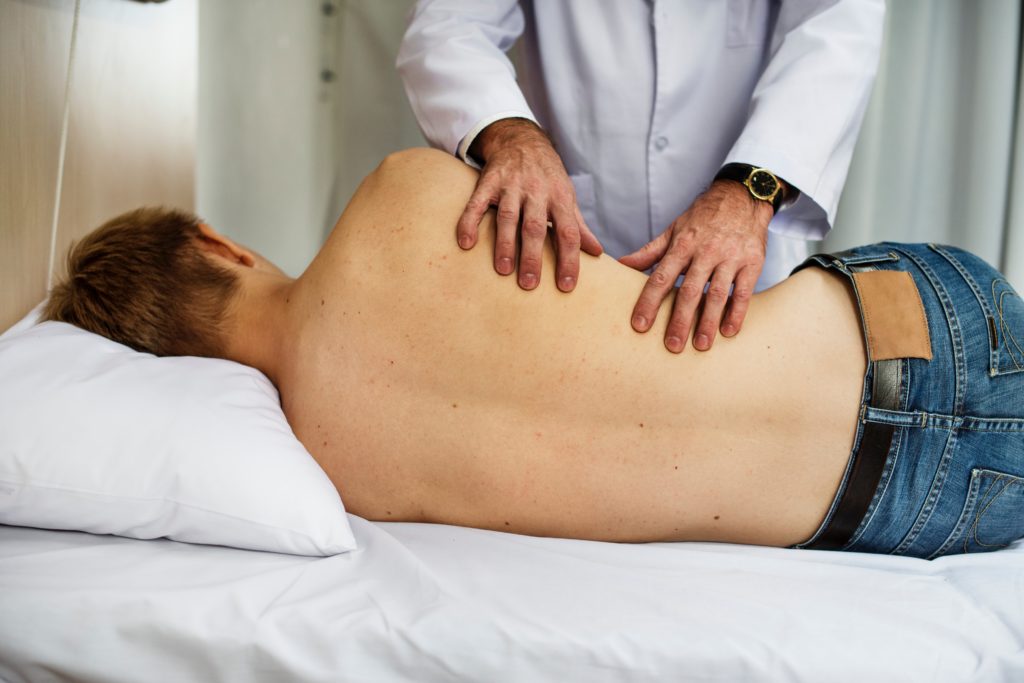
Low back pain is one of the most common health conditions. It affects thousands of people each year. It has been reported that a quarter of US adults would of have had low back pain sometime within the last three months. There are many different treatments for low back pain ranging from medications to exercise to natural therapies such as acupuncture. At Master Lu’s Health Center in Salt Lake City, we treat low back pain successfully utilizing acupuncture and Chinese medicine.
Recently, the American College of Physicians have recommended non-drug therapies to treat low back pain. The report came out also in response to help with the opioid crisis. One of the non-drug therapies they mentioned is acupuncture. The report was published in the Annals of Internal Medicine. Acupuncture is recommended as part of the first recommendation.
The first recommendation in the reports says: “Given that most patients with acute or subacute low back pain improve over time regardless of treatment, clinicians and patients should select nonpharmacologic treatment with superficial heat (moderate-quality evidence), massage, acupuncture, or spinal manipulation (low-quality evidence). If pharmacologic treatment is desired, clinicians and patients should select nonsteroidal anti-inflammatory drugs or skeletal muscle relaxants (moderate-quality evidence). (Grade: strong recommendation)”
Acupuncture and Chinese medicine is a complete medical system to diagnose and treat disease. It has been shown to be very effective for low back pain both acute and chronic. Acupuncture and Chinese medicine is a viable and natural form of medicine to help with low back pain and to avoid surgeries.
For the complete report from the Annals of Medicine click on Non-Pharmacological Therapies for Low Back Pain.
I hope this helps you with recommendations for low back pain and to become healthier in a more natural way. If you would like more information on acupuncture or would like to schedule an appointment please give us a call at Master Lu’s Health Center.
Acupuncture and Chinese medicine has been around for over 3000 years. Chinese medicine is a complete medical system to diagnose and treat disease. Throughout history Chinese medicine has been shown to be an effective form of medicine. For over 40 years, Master Lu’s Health Center in Salt Lake City has been helping people with various health conditions such as low back pain, knee pain, neck pain, stress, and anxiety utilizing acupuncture and Chinese medicine.
Though Chinese medicine has been around for so long, recently there has been more scientific research being done. Most of the research done has been for acupuncture. Recently, the Austrailian and Chinese Medicine Association did a study called acupuncture evidence project. The project showed several health conditions that acupuncture has been proven to be effective for. Some of the top conditions that acupuncture has been shown to help are migraine headaches, allergies, chemo induced nausea and vomiting, chronic low back pain, tension and chronic headaches, postoperative pain, and post operative nausea. The acupuncture evidence project shows and demonstrates the evidence that acupuncture works.
Among the top health conditions with strong evidence of effective most of the conditions are pain conditions. Acupuncture and Chinese medicine is effective for pain. We treat low back pain, neck pain, knee pain, and arthritis all of the time. You can argue that one of the main reasons someone comes to see us is because of low back pain. Why is acupuncture and Chinese medicine so effective with pain?
Whenever there is no free flow there is pain. Acupuncture will improve blood flow and circulation to help with the pain. The blood flow will facilitate your body’s self healing mechanisms. Acupuncture will also act on the brain releasing different chemicals, hormones, neurotransmitters, and endorphins to promote your body’s self- healing mechanisms.
At Master Lu’s Health Center, we specialize in pain management. We treat a variety of pain problems such as tendonitis, knee pain, bac pain, neck pain, and arthritis. Acupuncture will help you with your pain problems. It will help you feel pain free and improved energy.
Take a look at the acupuncture evidence project. You can see the scientific evidence that acupuncture is effective. If you have been having problems with pain and would like to look into acupuncture, feel free to call us anytime to schedule an appointment at Master Lu’s Health Center.
Have you been struggling with pain? Have you been to all of the doctors and you still have a lot of pain problems? Are you sick and tired of taking pain medications? We have a great and natural solution for you. Here at Master Lu’s Health Center in Salt Lake City, we specialize in pain management and pain condition utilizing acupuncture, Chinese herbs, exercise, and nutrition to help you feel better, more balanced, and pain free.
Acupuncture and Chinese medicine has been shown to help with many different pain conditions both acute and chronic. Acupuncture is effective for low back pain, neck pain, knee pain, arthritis, tendonitis, and other musculoskeletal conditions. In fact the Acupuncture Now Foundation have come out with some white papers and research on how acupuncture can treat pain, also acupuncture’s role in fighting the opioid epidemic. You can check out the white papers and research here https://acunow.org/whitepaper/
Acupuncture will improve blood flow and circulation that will promote your body’s self healing mechanisms. It will also at on the brain and will release your body’s natural pain killers and chemicals such as endorphins, neurotransmitters, and hormones that will balance the body and promote your body’s self healing mechanisms.
Hope this helps you understand more about how acupuncture can help you with pain relief. If you have any questions feel free to contact Master Lu’s Health Center anytime.
Here is a short video on acupuncture and pain management.
